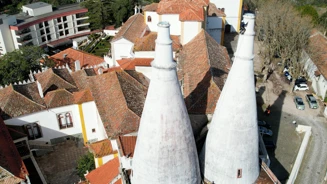Parques de Sintra restores the iconic chimneys of the National Palace of Sintra
26 Mar 2024
At the National Palace of Sintra, the conservation and restoration project of the monumental chimneys that mark the building's architecture is already underway. The intervention, which covers all of the vestments of the north wing of the Palace, consists of specific repairs to plaster mortars and subsequent whitewashing, with the aim of replacing the chromatic homogeneity of the exterior covering, safeguarding its integrity.
Within the scope of the heritage management and maintenance plan that Parques de Sintra is implementing at the National Palace of Sintra, the methodology of which includes the constant monitoring and analysis of the building, the need to intervene in the lining of the chimneys, which exhibit biological colonisation, was identified, as were specific areas of peeling, cracking and detachment of the plaster mortar. Consequently, the company decided to move forward with the conservation and restoration project, with a view to enhancing the Sintra National Palace, a core element of the town and the Sintra Cultural Landscape itself, elevated to World Heritage status by UNESCO in 1995.
The intervention represents an investment of 130 thousand euros and is expected to be completed by the end of the first half of 2024.
The National Palace of Sintra is the only surviving Portuguese medieval palace. A privileged witness to some of the most important episodes in the history of Portugal, it was inhabited for almost eight centuries by Portuguese monarchs and by the court, who appreciated hunting in the region and who took refuge here during plague outbreaks in the capital or during the summer months, due to the town's milder climate.
Over time, it took different forms and incorporated the artistic trends of each era, exhibiting various architectural styles today, Gothic and Manueline elements standing out, being strongly marked by the Moorish taste - a symbiosis between Christian art and Muslim art - evident in the exuberant Spanish-Moorish tile coverings.
The monumental kitchen and its iconic 33-metre-high chimneys, which became a symbol of the town of Sintra, were built in the 15th century, during the reign of King João I, to serve the entire Palace. With Sintra being a land for royal hunting, this was where the animals hunted would be prepared for banquets.
In the last decade, the parks and monuments managed by Parques de Sintra have received around 25 million visitors, and the company has invested 40 million euros in the built and natural heritage under its care. With no recourse to the state budget, Parques de Sintra is committed to a pioneering management model based on leveraging the heritage to generate income which is then reinvested in its recovery and maintenance. Continuing in the same vein, the company plans to invest around 30 million euros in the future to enhance the parks and monuments under its management.

